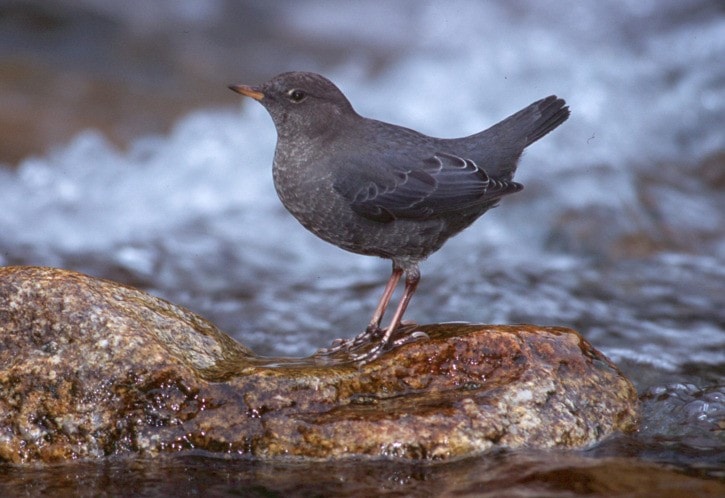The Naturalist, by Michael Morris
The sight of a dipper diving in to a fast flowing river in the middle of winter never ceases to amaze me. I have to remind myself that in winter the water temperature is warmer than the air temperature.
Dippers are a slate grey, fist-sized bird that resides year round in many streams in the valleys around Revelstoke. They get their name from their most conspicuous habit, a repetitive up-and-down bobbing motion, which is thought help them see prey from their position on a steam side rock. They feed by plunging into streams that flow fast enough to challenge my ability and courage to cross. They seek aquatic insects, mostly caddis fly and stonefly, and fish eggs — the same diet as a trout. These Dipper delicacies only occur in pollution free and well oxygenated waters. The presence of Dippers is a quick and reliable indicator of a healthy aquatic ecosystem.
Dippers hunt the gravel bottom by using their wings as hydrofoils, walking into the current while tilting their wings to hold them down. While underwater, a thin, third eyelid closes from the side to protect their eyes. They pop back to the surface with their natural buoyancy, created by capturing air between their feathers. They waterproof their feathers by applying oil from a gland during preening. Polluting substances in the water, such as soap or highway spills, will compromise the effectiveness of their waterproofing.
Dippers nest along streams at sites that provide shelter from predators and floods. Typical nest locations are under bridges, behind waterfalls, or on stream side cliffs. During last spring’s breeding season I watched one fly into a rock crevice between the two spouts of Begbie Falls, likely to a nest. Most nests are constructed of vegetation, dome-like with a side entrance and an outer shell of moss interwoven with stems and roots. Nests also serve as winter roosting sites.
Dippers have a distinctive “jik-jik” call note heard when they defend stretches of creek habitat from other dippers, or during close formation courtship flights. Less often heard is their lyrical song, seemingly an indicator their satisfaction after a successful feeding session. John Muir described their song as “the music of the streams refined and spiritualized.”
As winter progresses and the higher elevation streams become increasingly closed over with snow and ice, dippers are moving down to the Columbia River and its larger tributaries looking for open water in which to forage. They can be seen dipping, poised to dive from rocks and ice edges into the rushing flow. As with most birds, they are tolerant of observers if you remain still. To improve your view, wait until they are underwater before moving closer.
To tune your ear to what dippers sound like, go to www.natureinstruct.org/dendroica. This website is a joint venture of Canadian, American, and Mexican government wildlife agencies that provides sounds, photos, and distribution maps for all North American birds.
